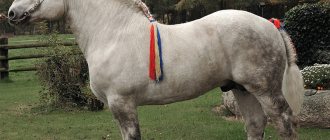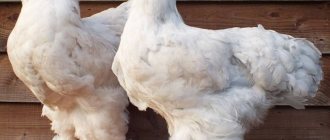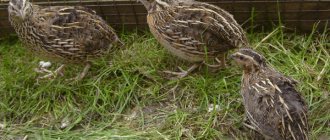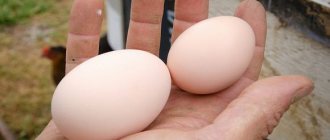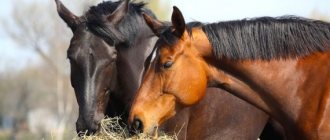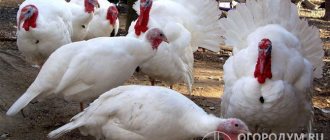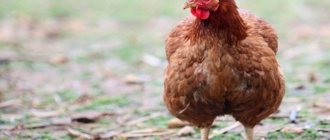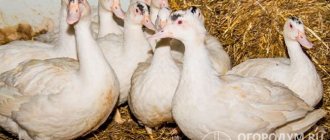If it is important for you to have both high egg productivity and good tasty chicken meat, then you need to choose meat and egg breeds of chickens. These chickens combine two directions in poultry farming: egg and meat, but at the same time both of these qualities are on equal terms. Meat and egg chickens will also be able to decorate your yard with their beauty and majesty; by the way, the appearance of some representatives is in no way inferior to decorative chickens. The best, in the opinion of many chicken owners, are the following breeds: Plymouthrock, Faverol, Zagorskaya Salmon, Poltava Clay, Yerevan, Viadont, Australorp, Amrox, Velzumer, Maran, Yurlovskaya Volosistaya, Holosheynaya, Moscow Black, Ameraucana, Sussex, Californian, Hercules.
Plymouth rock chickens
The Plymouthrock breed comes in three varieties: Russian, American and English. This breed resembles the Dominant in color, but they are two different breeds.
Plymouthrocks were created by crossing Brahma, Domenican and Cochin in America in 1910.
There is also a mini version of this breed called the Dwarf Plymouthrock. White and striped Plymouth Rocks are most often bred on farms.
The plumage color of laying hens is darker, while that of cockerels is lighter. Very often you can find such shades of Plymouth Rocks as gray, speckled, striped, silver, partridge, yellow and hawk.
Striped Plymouthrocks have a fairly decent weight, a cockerel can be up to 4 kg, and a hen from 2.7 to 3 kg, but egg production ranges from 180 to 200 eggs per year weighing up to 60 grams. Chickens begin to lay eggs at 6 months.
Chickens of the Zagorsk salmon breed
The Zagorskaya Salmon breed was selected in Zagorsk, now the city of Sergiev Posad in Russia in 1955. Breeders crossed the Russian White, Yurlovskaya Volosistaya, New Hampshire and Rhode Island breeds with each other and got such a beautiful chicken.
Why salmon? Because chickens have salmon-colored feathers on their chests, it is noteworthy that only chickens have such feathers.
Zagorsk chickens do not have an impressive weight; on average, chickens weigh 2 or 2.5 kg, and cockerels from 3 to 3.6 kg. Hens lay eggs from 5 or 5.5 months, while per year one hen can produce from 220 to 260 eggs weighing 65 grams, but sometimes there are eggs weighing up to 89 grams.
Broiler specifics
Many novice poultry farmers plan to breed broilers at home. The main thing is to provide the young animals with nutritious food. At the very beginning of breeding, chickens should be given starter feed, to which it is useful to add a finely chopped chicken egg. Water should be poured into special drinking bowls to prevent the chickens from accidentally getting wet. Young animals should always have food in their feeders, but it should be changed regularly to avoid souring.
Broyels do not provoke fights, and despite their large size and considerable strength, they often suffer from attacks from their smaller breeds, which are more aggressive.
Gradually, bone meal, chalk or crushed eggshells can be introduced into the diet. Be sure to add fresh spring greens. At the beginning of cultivation, the temperature should be at least + 350C, which is gradually lowered by about 2 degrees per day.
Chickens of the Poltava clayey breed
The Poltava Clay breed found its way to Poltava in the mid-19th century. Poltava breeders crossed Orpingtons, New Hampshires and Wyandottes with each other, and in 1951 the breed was introduced to the world.
There are two types of Poltava color: Zozulyasty and Black.
The weight indicators of the hens are as follows: the weight of the hens is from 2.2 to 2.5 kg, the weight of the cockerels is from 3 to 3.5 kg. The egg production of one chicken is from 180 to 200 eggs per year, weighing 56 grams, the shell is of good thickness.
Chickens of the Yerevan breed
Yerevan breed was developed in Armenia in 1974. Armenian breeders crossed local chickens with New Hampshire and New Island chickens and obtained a good meat and egg breed adapted to the local climate.
At two months, this breed of chicken weighs only 800 grams; subsequently, hens grow from 2.2 to 2.5 kg, and roosters can grow up to 4.5 kg.
At approximately 5.5 months, hens begin to lay eggs; per year, one hen produces from 180 to 210 eggs weighing from 58 to 60 grams. This breed also has record holders for egg production; record holder chickens produced from 270 to 290 eggs per year.
Feeding chickens for meat and eggs
As for feeding such chickens, they have a slow metabolism. Delayed egg formation occurs. Chickens lead a sedentary lifestyle and are prone to overeating, which leads to the accumulation of subcutaneous fat, which is deposited in their liver. This leads to the fact that the hormonal regulation of egg formation processes is inhibited, feed costs increase, and the biological quality of eggs decreases.
In order to avoid this, they create a balanced diet, that is, nutrition should be aimed at stimulating the growth of live weight and the formation of eggs.
All breeds of this type consume much more feed than ordinary chickens. Therefore, they follow the diet, distributing three types of feed with an interval of 6 hours:
- grain mixtures of oatmeal, corn and millet;
- wet mash with meat and bone or fish meal, milk or cottage cheese;
- cereals (different type daily).
To increase egg fertilization, roosters are given 50 g of sprouted grain at the rate of 20 mg per 1 kg of feed. Meat and egg chickens are the best category for economical feeding with excellent results aimed at profit.
So, you can get a good income from raising meat and egg breeds of chickens. They have a calm character, are unpretentious in their maintenance, and attractive in appearance. In addition, they can supply their owner not only with juicy and healthy meat, but also with large eggs, which they keep for themselves or put on sale.
0
0
Copy link
Chickens of the Viadot breed
The Wyandotte breed has recently been bred as an ornamental breed rather than a meat and egg breed. Wyandottes come in standard and dwarf varieties. As for colors, the standards have about 15, and the dwarf ones 28 shades.
In farmsteads you can see blue with different edging, silver, white and red, partridge, striped, golden, red with different edging, red with black edging, white gold, silver and black edged and even monotonous black and white Wyandottes.
If we talk about the beginning of oviposition, then dwarfs begin earlier at 4-5 months, while standards start from 6 to 9 months. One hen per year can produce from 130 to 140 eggs weighing 53 grams. The weight indicators for chickens are as follows: standard hens up to 3 kg, roosters up to 3.8 kg, dwarf chickens 900 grams, roosters 1.2 kg.
Australorp chickens
The Australorp breed was developed by Australian breeders in 1890. Initially, this breed was obtained from black Orpingtons, and then improved by crossing with Cochin, black Langshan, Minorca, black Plymouthrock.
Black chickens look very exotic in the backyard, but in the summer it is necessary to equip them with a place with shade so that they are not exposed to sunstroke, since the sun hits the black color the hardest.
The chicken lays the first egg at 5.5 months and in a year can produce up to 220 eggs weighing 55 grams. The weight of hens is 2.2 kg, and that of cockerels is 3.5 kg. The combination of good meat production and egg production makes this breed popular among many breeders.
Chickens of the Amrox breed
The Amrox breed has two versions of origin. According to one version, the breed was bred in Germany in the mid-20th century; according to the second version, the chickens came to us from Massachusetts, North America.
If you want to buy a real Amrox, then make sure that in front of you there is a hen and a cockerel of cuckoo color, this breed has only this color, and the hens are much brighter than the cockerels.
Egg production in chickens begins at 5.5 months. In a year, a chicken produces up to 200 eggs, 60 grams each. The weight of the chicken is up to 3 kg, and the cockerels can weigh up to 4 kg. Striped Plymouthrocks and Dominants look much duller than Amroks, but everyone chooses the bird for themselves.
Flaws
- slow weight gain;
- significant risk of loss of livestock when kept in cages;
- low egg production rate with unskilled approach.
Taking into account the main characteristics, we can come to the conclusion that breeding a universal type of chicken is relevant and extremely profitable in private farms.
Chickens of the Welsumer breed
The Welsumer breed is over 100 years old, its creation dates back to 1900, thanks to the crossing of Malayan Dorkings with the local partridge chickens of the Welsumer village, which is why the breed bears the same name.
Welsumers were bred in Holland and belong to the meat and egg category. To buy a purebred bird, pay attention to the following features: cockerels have a pattern of three parts of feathers on their chest, and if the chicken has a lot of black marks and a lot of bright spots, then this is clearly a defect.
In a year, one hen produces up to 170 eggs weighing up to 65 grams, which are quite large by the way. The weight indicators are not very outstanding, but they pay off with the good taste of the meat; chickens grow up to 2.1 kg, and cockerels up to 2.8 kg. There are also dwarf Welsumers.
Chick selection
It is recommended to buy chickens for replacement of livestock at large poultry farms or from trusted large breeders. Inexperienced owners often make mistakes in breeding and crossing chickens.
When choosing chickens, you need to pay attention to the following signs:
- Behavior is active. The chicks do not sit still, squeak softly, do not huddle in a corner or huddle together.
- The abdomen is not distended, elastic to the touch. There are no traces of feces, pus or blood near the cloaca.
- The eyes are alive and clear. There are no stuck areas around.
Chicks must have an active behavior.
To check the chicken's health, you can close it in a small cardboard box and lightly tap the lid. A healthy chick will quickly approach the source of the sound.
Before purchasing, it is recommended to find out the average price of chickens. A discount of more than 10% may indicate culling or other deficiencies in the brood. The future owner should evaluate not only the appearance and condition of the chicks, but also the exterior of the parent individuals.
If you have a warm, equipped chicken coop and experience in rearing, you should choose day-old or week-old chickens. You need to buy them in April in order to get a sufficiently mature herd in October-November.
If there is no insulated room, you can purchase 30-day-old chicks. Before purchasing, you need to find out whether the chickens are vaccinated and with what vaccines.
Chickens of the Maran breed
The Marans breed was bred in the city of Marans in 1895. Chickens of this breed can rightfully be called the main character of the fairy tale “Ryaba Hen”, because they give “golden” eggs of a beautiful red-brown hue, many also call these chickens “Easter”, because in addition to the golden hue, the eggs look like they were painted with onion skins.
The colors of the Marans are also replete with their colors. It is very common to see black and copper, black, silver and gold cuckoo, white, wheaten, Columbian, silver and black or turquoise and black-tailed buffs.
There are also dwarf marans, their weight is 1 kg for cockerels and 900 grams for hens.
Standard marans have much larger dimensions: cockerels from 3.5 to 4 kg, and hens from 2.6 to 3.2 kg. Hens begin to actively lay eggs at 5-6 months, while from one female you can get from 130 to 150 eggs per year weighing up to 85 grams, and the breed standard tells us that one egg weighs up to 100 grams.
What are they characteristic of?
Let's consider the direction of meat-egg chicken breeds in Russia with a description and find out which ones to choose? It is accepted as a basis that such a breed has a lighter and more proportional frame , unlike breeds that are raised for meat, but is slightly larger than those chickens that only lay eggs. Their plumage is quite thick and uniformly dense.
This allows the bird to adapt well to sub-zero temperatures. Without additional lighting, egg production may decrease in winter. A mandatory requirement for keeping such chickens is a clean and dry poultry house or cage, without the slightest suspicion of drafts.
The meat-egg type of bird is considered more active and inquisitive , and more prone to “communicate” with people. Such chickens are characterized by average indicators of both egg production and weight gain for slaughter: about one hundred and eighty eggs during the year and weight gain of up to four kg in males and slightly less in hens. Puberty occurs at five and a half to six months. If you are raising chickens in your backyard, then you need to think about dividing the poultry population into a family of chickens that will reproduce their kind (precisely to obtain eggs for incubation or hatching by the hens themselves), into chickens that will lay eggs for sale, and chickens and cockerels that will be fattened for meat.
It’s worth doing this in order to know which chickens will be best fed.
Chickens of the Yurlovskaya vociferous breed
The Yurlovskaya Volosistaya breed is a very stately and beautiful breed. If you like to listen to roosters crow, then Yurlov chickens are created especially for you. Roosters of this breed sing much longer and louder than others, which is why their second name is vociferous.
Yurlov chickens are a miracle of Russian folk selection. Work on breeding the breed was concentrated in the Voronezh, Oryol and Kursk regions, and the name of the breed came from the village of Yurlovo.
The cockerels were selected for their ringing and prolonged singing. The older the Yurlovets cockerel, the more beautiful he sings.
Chickens begin to lay eggs at 8-9 months. The productivity of chickens in terms of eggs is as follows: one hen per year produces from 140 to 170 eggs per year, weighing from 60 to 70 grams, there are cases of very large eggs up to 90 grams. In terms of weight, cockerels can be called record holders; they grow up to 6 kg, and hens on average up to 4 kg.
Main bird crosses
Crosses by their origin are hybrids of other bred breeds.
As a result of selection, there can be from two to four lines. When naming, a corresponding number may be used indicating the number of lines. The vast majority of new highly productive crosses for both egg and meat production are based on 4-linear hybrids. They are bred to increase both egg and meat productivity. Among meat-egg crosses, the following breeds are considered the best:
- "Australorp."
- "Adler silver".
- "Necks."
- "Kuchinsky Jubilee".
- "Rhode Island".
- "Orlovskaya vociferous."
Features of care: If something is wrong with the bird, then by its behavior it will be able to warn the owner in time. You need to be careful about how chickens make sounds. As a rule, while awake, birds are very active, so they sing and cackle a lot. In the event that the bird is sick, there will be silence.
When someone frightens a bird, it shows it even more loudly than usual. The frightened bird begins to lay eggs poorly, but after the stress passes, it resumes its activity again. Chickens that start to get sick usually stop eating or eat very little. They are in a relaxed state, their head tucked under the wing or lying with their neck extended.
The bird's comb begins to wrinkle, acquiring a blue or yellow tint. Feathers are ruffled. Such a bird needs to be removed from the general flock, for treatment and the risk of infection of other birds. To ensure efficient consumption of feed, it is worth removing from the general flock chickens that do not lay eggs well.
Reference! Layed eggs should be removed from nests in a timely manner; this will suppress the brooding instinct, which is more developed in meat-egg breeds if the eggs are needed for incubation.
Chickens of the "Neckless" breed
The Bare Neck breed is a very exotic breed, especially in appearance. These chickens look like turkeys. Many consider Romania, in particular Transylvania, to be the homeland of these chickens, but there are versions that the homeland of this breed is Hungary and even Spain, the province of Andalusia.
The appearance, as you can see for an amateur, is a very exotic appearance.
At the same time, chickens weigh from 2 to 3 kg, and cockerels up to 4 kg. The egg production of this breed is not too high; one hen produces from 130 to 160 eggs per year, weighing 58-60 grams. The bare-necked chicken is more of a decorative breed of chickens and most people keep them for the sake of exoticism.
General characteristics
If you look closely at the name of the group, you can safely conclude that from the universal bird you can get not only a large number of eggs, but also sufficient meat. Each breed has individual external characteristics, the same applies to productive qualities, but there are a number of common features characteristic of all birds:
- strong physique;
- rapid ripening;
- most chickens show good egg production in winter;
- presence of maternal instinct.
As for the maintenance of meat-egg representatives, most breeds will not require the creation of any special conditions. Birds have a calm character; a closed chicken coop is suitable for them to live in. The presence of a walking aviary will be an undoubted advantage for creating a comfortable life for chickens, but universal birds can do just fine without such excess.
Chickens of the Moscow Black breed
The “Moscow Black” breed was created at the Moscow Agricultural Academy “Solnechnoye” together with the poultry department of the Brattsevskaya poultry farm in 1980.
To obtain the Moscow black, New Hampshire, Brown Leghorn and Yurlovskaya vociferous were crossed with each other. A relative of this breed is the Moscow White breed, created in 1957.
Chickens begin to lay eggs at 5.5-6 months and in a year one hen produces from 210 to 230 eggs weighing from 59 to 62 grams.
Moscow black does not have high meat indicators, but the quality of the meat makes this drawback invisible. The weight of the chicken is from 2 to 2.3 kg, the weight of the roosters is from 2.7 to 3.5 kg.
Ameraucana chickens
The Ameraucana breed, like the Araucana, lays colorful eggs and is also considered an Easter chicken. There are not very many Easter chickens; the most prominent ones are Araucana, Maran and Ameraucana.
This breed of chicken appeared in America in 1970 due to the crossing of Araucan with local chickens, but was entered into the breed register only in 1984.
The color of birds is very diverse, but the following colors are recognized as official: white, black, blue, red-brown, silver, wheat, dark yellow and blue with a wheat tint, with rare exceptions there are lavender tones.
There are both dwarf and decorative Ameraucanas. A chicken produces from 200 to 250 eggs per year. The weight of a chicken is from 2 to 2.5 kg, and that of a cockerel is up to 3.5 kg.
Sussex chickens
The Sussex breed is the ancestor of many breeds of chickens, for example the Adler Silver. This breed was developed in England in 1845.
These chickens are distinguished by good productivity, and the variety of colors of the birds will not leave anyone indifferent.
There are 8 primary colors of the bird: Colombian, brown, fawn, red, lavender, silver, parcel, white.
The chickens got their name from the county of Sussex of the same name, where they were bred. The chickens got these colors due to the fact that their parents were crossed with Brahma, Cochin and silver-gray Dorkling.
Sussex cockerels weigh on average 4.1 kg, and laying hens 3.2 kg, while one hen produces from 180 to 200 eggs per year.
The most beautiful or “royal” are the lavender Sussexes; the color is quite rare, but breeders are trying to increase the number of birds with a similar color.
Breeding chickens at home
The best egg breeds of chickens do not cause any difficulties in breeding. They live in simple chicken coops. The sizes depend on how many birds the breeder breeds at home. But on average there are no more than 4 chickens per square meter of area. In the southern regions, a simple chicken coop is made, in the middle regions it is necessary to insulate the chicken coop, and in the northern regions, heating is usually installed in the chicken coops. A winter chicken coop is suitable for any region.
Perches and nests are set up inside the premises so that the chickens can lay eggs normally. There should also be a separate place for food, water, a basin with ash and sand. Lighting is mandatory, and at least primitive ventilation must also be established.
Important! When additional lighting is provided in winter, the productivity of laying hens increases by 30-40%.
It wouldn't hurt to set up a walking area. It should be spacious and protected from rain. You can plant different herbs inside so that the chickens have something to eat.
The diet is selected according to possibilities. You can keep chickens on feed or make your own grain mixtures and vegetable mashes
But it is very important to ensure that the birds do not eat too much, otherwise obesity will appear, and it will have a bad effect on egg production.
Breeding chickens for eggs at home can be done naturally or using an automatic incubator. Only at home, only pure breeds of chickens are bred, and not crosses. If it is necessary to obtain a cross, the birds are purchased from poultry farms, because a chicken hatched from a cross egg will not have the qualities of its parents.
When raising egg-laying chickens, you need to pay special attention to cleaning the premises. The chicken coop and the run are kept clean and tidy.
Troughs for food and water are washed every day, bedding is changed approximately every 3 days, although this depends on the type of bedding. By keeping the chicken coop clean, you can protect your birds from many diseases. And a healthy bird always lays high-quality, tasty eggs.
Chickens of the "California" breed
The Californian breed is very similar to the Plymouth Rock and is often confused because the breed was created by crossing Plymouth Rocks with Leghorns in 1900 by Horace Dryden.
A professor at the Oregon Agricultural College crossed a Plymouth Rock with a white Leghorn and got these beauties.
Despite its lack of popularity, many breeders keep this breed of chickens because of their attractive appearance.
It should be noted that the color of cockerels is lighter than that of hens.
The weight indicators of Californians are as follows: cockerels about 3 kg, hens up to 2 kg.
One hen produces up to 200 eggs per year.
